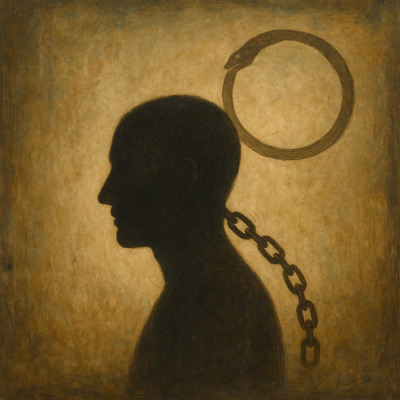Or should we express them?"
One day, a word, a situation, an occurrence becomes a storm inside us. If we are mature enough to recognize and understand this situation, we try to understand it, we try to be logical rather than reactive.
Sometimes we keep that emotion bottled up inside and put a fake smile on our face and continue the conversation as if nothing happened, sometimes we start to frown without even realizing it, and when someone notices and asks us what happened, we say "nothing, I was just lost in thought".
Have you ever thought about which of these behaviors is healthier? How to approach it, what to do so that it doesn't grow like an avalanche inside us, so that our stress doesn't turn into our character, so that we don't get trapped in the same cycles as fate...
Let's try to look at it from this point of view; we always say that negative emotions harm us, if we are ashamed, angry, angry and suppress them, it feels bad. But if we suppress happiness, joy, pride, love, what kind of situations can these cause in us?
In this article, we will try to dig deeper into the issues such as whether it is healthier to suppress or express emotions, and what we can do to protect the natural flow of our emotions and to process them in a healthier way.
Let's start examining the subject together from philosophical, scientific and social perspectives, as always.
The Philosophical and Scientific Background of the Subject
The philosophical perspective:
Spinoza: Causes of Emotions and Liberation
(*1)
The Origin of Emotions
Spinoza's view is that emotions (affectus) arise from our becoming conscious of the changes that the mind and body experience together.
We often think that our emotions arise "spontaneously", but Spinoza argues that every emotion arises for specific reasons. To give an example, anger is not just a "sudden outburst" but a state of cause and effect that arises when our preconceived expectations do not coincide with reality.
According to him, the way to transform our emotions from "having absolute power over us" into something we can make sense of is to analyze this chain of cause and effect.
The Liberating Effect of Understanding
According to Spinoza, the greatest step of human liberation is the ability to move from passive emotions (passiones) to active emotions (actiones).
Passive emotions:
These are feelings such as fear, anger, jealousy, etc., which we have no control over, whose causes we do not know, and which drive us
Active emotions:
Feelings such as understanding, love, joy, etc., whose causes we know and are conscious of, and which empower us.
When we understand the cause of an emotion, our automatized reactions to it, whose causes we do not even know ourselves, are reduced. If we can achieve this, we are more likely to choose our own behavior. In this way, instead of perceiving the emotions we experience as "this event made me angry", we can approach them as "I felt angry because this event did not fulfill this expectation in me."
This point of view gives us the perception that we manage life through our own choices, rather than thinking that life happens to us.
A More Harmonious Relationship with Life
Spinoza believes that our purpose in life is not to suppress our emotions completely, but to understand and transform their natural flow. According to him, analyzing the causes of our emotions increases both our mental resilience and our openness in our relationships with other people, which in the long run leads to a more coherent, balanced and peaceful life.
Martha Nussbaum: Emotions Are Ethical Judgments
(*2)
Martha C. Nussbaum is considered one of the most influential philosophers of our time, especially for her work on ethics, political philosophy, law and the philosophy of emotions.
Let's take a look at his approach.
The Rational Aspect of Emotions
Martha Nussbaum considers emotions not only as biological reactions, but also as part of our ethical judgments.
For her, emotions are indicators that reflect our deepest beliefs about what we value.
For example, feeling sad when a loved one is harmed is not only a hormonal response, but also a result of our judgment that "that person's well-being is valuable to me".
In other words, emotions make quiet but powerful statements about the goals and priorities we value.
The Moral Content of Emotions
According to Nussbaum, every emotion has a story and a contextual meaning.
To give a brief example:
When we feel that our sense of justice has been violated, we feel anger.
When we feel that our sense of justice has been violated, we feel guilt.
When we feel joy, we feel joy at the realization of things we find valuable.
This perspective suggests that we should understand the ethical function of our emotions rather than suppressing them. For emotions are the guiding beacons of our moral compass.
The Moral Cost of Suppressing Emotions
If we suppress our emotions, not only our psychological health is weakened, but also our moral sensitivity.
If we constantly suppress our anger, it can dull our pursuit of justice.
If we suppress our sadness, it can diminish our empathy for the suffering of others.
If we suppress our joy, it limits our capacity to recognize the beauty of life.
Thus, Nussbaum argues, a healthy life requires that we engage in an open dialog with our emotions.
Processing Emotions as Ethical Judgment
Nussbaum suggests some steps for understanding and processing emotions:
Recognize the trigger of the emotion:
What caused us to feel this emotion?
Recognizing the value underlying the emotion:
What value has this event touched on that we see as a value?"
Determine the action to protect the value:
How can we respond ethically and constructively when we experience this emotion?
Following these approaches helps us to make our emotions both self-awareness and an instrument for ethical development.
"Observing Emotion" and Non-identification Approach in Buddhist Psychology
(*3)
According to Buddhist psychology, emotions, They are not permanent and unchanging entities. Just as clouds come and go, similarly emotions stay for a while and then pass.
The problem arises when we identify with these emotions.
For example, when we say, "I am angry," we equate ourselves with anger, whereas the Buddhist perspective suggests saying, "I have a feeling of anger." So we see anger as a passing experience, we don't let it define us.
In short, we are us and anger is anger. We remain, anger comes and goes. If we identify with ourselves, the anger stays with us, and this means that we persecute ourselves.
Central to this approach is the practice of mindfulness. Observing the emotions in our minds without judgment, acknowledging their presence without getting caught up in them, both increases our mental stillness and prevents us from reacting automatically.
Non-identification allows our emotions to come and go without harming us, which is a powerful tool for both personal peace and more balanced relationships.
Scientific perspective:
Effects of Suppressing Emotions on the Immune System
Stanford University psychologist James Gross, In his research on emotion regulation, he draws particular attention to the strategy of emotional suppression. (4*)
Emotional suppression is the conscious control of one's facial expression and behavior rather than expressing the emotion one is feeling.
These studies show that suppression of emotions may prevent conflict in the social environment in the short term, but in the long term it has negative effects on physical and mental health.
The results of the research are intriguing...
Increased physiological stress
Suppressing emotions keeps the heart rate and blood pressure high for a long time. The stress this creates continues to build up and, if left unaddressed, can set off alarms in the body and leave us vulnerable to disease.
Suppression of the immune system
If stress hormones (especially cortisol) are constantly elevated, our immune system weakens and we become less resistant to infections.
Emotional exhaustion
Suppressing emotions depletes our mental resources, increasing our risk of both fatigue and depression.
Gross's work suggests that healthy mood regulation is possible through cognitive reappraisal, rather than suppressing emotion altogether.
That is, putting the emotion-triggering event in perspective not only reduces emotional intensity but also prevents the negative impact on our immune system.
The Role of Expressing Emotions in Social Bonding and the Brain's Reward System
Expressing our emotions not only helps us to relax internally; It also strengthens our social bonds and activates our brain's reward system.
Research shows that when we share our feelings honestly and openly, there is a marked increase in the activation of areas of our brain associated with social interaction and pleasure. (5*)
Oxytocin Release
Intimate emotional sharing increases the body's levels of the hormone oxytocin, known as the "bonding hormone". This hormone reinforces trust, strengthens empathy and improves the quality of our social relationships.
Increase in Dopamine Activity
When we share our feelings, it triggers the release of the hormone dopamine, our brain's reward mechanism.
This motivates both the speaker and the listener, and the sharing itself becomes a rewarding experience.
Social Support Mechanism
The emotions we express automatically trigger the supportive behavior of those to whom we express them. This both increases our psychological resilience and facilitates the processing of negative emotions.
From a neuroscience perspective, expressing our emotions rather than suppressing them activates our brain's "engagement/reward" cycle, creating a healing effect on both an individual and societal level.
Social and cultural perspective:
The Norm of Emotion Suppression in the Name of "Professionalism" in Modern Business
The concept of "professionalism" in today's business culture, It has often become synonymous with not showing emotions.
In meetings, not showing our anger, disappointment, or even excessive joy; "keeping to ourselves" and appearing "cool" is presented as a necessity for moving up the career ladder comfortably.
This norm is rooted in the understanding of emotion management that has developed in corporate culture since the mid-20th century.
The origin of this norm lies in the understanding of emotion management that has developed in corporate culture since the mid-20th century.
Particularly in the service sector, a "positive" facial expression is expected from employees in the name of customer satisfaction; however, this has spread to other sectors over time and has turned into an expectation to "neutralize every emotion".
When we turn the camera to the "customer is always right" perspective, we are expected to hide our emotions and maintain customer satisfaction even in the face of heartbreaking customer behavior.
Research shows that this self-imposed emotional control increases the risk of burnout syndrome, loss of empathy and psychological alienation in employees in the long run.
What's more, suppressing emotions at work can weaken team communication and negatively affect creative problem-solving skills.
Therefore, redefining the concept of "professionalism" in the modern business world and promoting a work environment that allows for healthy expression of emotions and empathy becomes critical for both employee health and corporate productivity.
Emotional Intensity in Different Cultures: Turkey vs. Europe
The expression and intensity of emotions vary greatly from culture to culture.
To understand this better, it would be good to briefly understand the difference between high-context and low-context cultures. (6*)
In high context cultures (e.g. Turkey, Japan, Arab countries, Latin America) the communication style is more indirect, based on nonverbal cues such as implication or gesture/mimic. Relationships in these cultures are generally long-term, based on trust and closeness. Emotions are more open, intense and sincere.
In low context cultures (e.g. Netherlands, Germany, USA, Scandinavian countries) the communication style is more direct, based on words. In these cultures, relationships are task or issue oriented, and individual space and privacy are seen as more important than in high context cultures. Accordingly, emotions are experienced in a more controlled and restrained manner.
In short, the main difference is this:
High-context cultures extract the message from the "context" (environment, body language, relationships); low-context cultures receive the message from the words themselves.
In high-context cultures such as Turkey, emotions are generally expressed in more open, intense and non-verbal ways.
Intimacy and emotional warmth are seen as important values in family, friend and business relationships. Emotions such as joy, anger or sadness can be shared freely, even in public.
In contrast, in many European countries (especially in low-context cultures such as the Netherlands, Germany or the Scandinavian countries) emotional expressions are more controlled and restrained. In addition, because the communication is direct, the other person's feelings are not so important.
For example, if you stand in a bike lane without even realizing it, someone might yell at you to move away, and how you feel in that situation is not so important. This is considered normal in low-context cultures, but not so much in high-context cultures, and sometimes a fight may even break out.
In social relationships, individual space, privacy and emotional stability are emphasized. This does not mean that emotions are suppressed, but the expression is calmer, indirect and based on verbal communication.
Research shows that these cross-cultural differences are not only due to social norms, but also to emotion regulation strategies learned in childhood.
In Turkey, children are encouraged to express their emotions more openly, whereas in many European countries the values of "balance" and "control" are taught at an earlier age.
These differences can also lead to misunderstandings in cross-cultural communication. For example, loud laughter or intense body language that is seen as a sincere gesture in Turkish culture may be considered excessive or inappropriate in more distant cultures.
Real Problems and Solutions
What's wrong with the current system?
"Emotions are not controlled, The harm of the "suppressed" stereotype
There is a prevailing belief in modern societies (especially in business, in formal relationships or in cultures where the pressure to "appear powerful" is intense). It is said: It is possible to control our emotions by suppressing them.
This approach may help us avoid conflicts, fights and disagreements in the short term, but in the long term it carries serious risks for both mental and physical health.
The emotions we suppress accumulate unprocessed in our subconscious mind.
Research shows that chronically suppressing our emotions has a negative impact on our immune system, keeps stress hormones (cortisol) high and increases the risk of depression/anxiety.
Moreover, because suppression does not help us understand the source of our emotions, it can cause us to react more violently when the situations that triggered the emotion are repeated.
Philosophically speaking, Spinoza says that understanding the causes of our emotions is the first step to transforming them.
Suppressing is the opposite of understanding, it alienates us from our inner world.
The risks of understanding that "it is best to express every emotion in the moment"
On the other hand, there is another extreme to suppressing emotions: "Express your feelings immediately, no matter what, don't hold them in."
This approach, while attractive from the point of view of individual freedom and self-expression, is not healthy in all cases.
Because emotions can be immediate, intense and sometimes based on misinterpretations. Instantaneous expression, especially in high-intensity emotions such as anger, jealousy or resentment, can lead to irreversible relational damage.
Neuroscience shows that these amygdala-driven knee-jerk reactions occur before the prefrontal cortex is engaged, i.e. no "logical filter" is applied.
There is therefore a critical difference between "living in the moment" and "reacting in the moment".
The healthy approach is not to suppress the emotion, but to first recognize it, name it, understand how it is felt in the body and then express it without hurting the other person by using a contextually appropriate form of expression.
This is a responsible attitude towards both ourselves and the other person.
Solution Suggestions
Emotion Regulation Techniques
Labeling
Recognizing and naming the emotion, is the first step in regulating that emotion. An fMRI study at UCLA found that people who verbally labeled their emotions had reduced amygdala activity and more active prefrontal cortex.
Saying "I am angry right now" can change the way the brain processes emotion.
When we feel the emotion, we can pause briefly, give it a name (right now I feel "jealousy", "disappointment", "excitement", etc.) and, if possible, rate its intensity on a scale of 1-10.
Example:
Reframing is the technique of reinterpreting an event or situation from a different perspective.
It is also known as cognitive restructuring in psychology. For example, if instead of saying "My boss is angry with me, which means I am incompetent" we think "My boss is under pressure, his reaction is not to me but to the general situation", we can significantly reduce the stress that this emotion creates on us.
Once we realize the source of the emotion we are experiencing, we can re-evaluate the same event from a more positive or neutral perspective. The aim here is not to deny reality, but to see that the negative interpretation is not necessarily true.
Somatic Release
Emotions that are released or felt intensely create tension, contraction and energy accumulation in the body.
Physically releasing this accumulation helps to regulate the nervous system. Yoga, breathing exercises, running, going for a walk, dancing, or even a few minutes of stretching can do this.
When you feel the emotion intensifying, take a short walk, take deep diaphragmatic breaths, and do movements to relax your shoulder and neck muscles. This physical release with awareness will relieve the mental pressure of our emotions.
When we use these three techniques together, we can process our emotions in a healthy way, without suppressing them, without expressing them immediately and destructively. The first step is to recognize and name it, the second step is to change its mental framework, and the third step is to balance its impact on the body.
Artistic and Creative Ways of Expression (Music, Painting, Writing)
Throughout history, art has been not only an aesthetic activity, but also a powerful tool for processing and transforming emotions.
Since ancient Greece, music, painting and literature have been used as forms of expression of both individual and collective human moods.
Music
Neuroscientific studies show that listening to or performing music has a direct effect on the limbic system, promoting emotional balance by increasing the release of neurochemicals such as dopamine, serotonin and oxytocin.
Playing an instrument, singing or simply listening is a powerful way to express and regulate complex emotions.
When we feel angry, practicing a rhythmic drumming, when we feel sad, listening to slow-paced classical music or personally meaningful songs, or even performing them if possible, can help us express emotions.
Painting and Visual Arts
Visual arts, such as drawing, painting or sculpture, give body and form to emotions where words fall short.
Studies in the field of art therapy show that visual forms of expression help to safely externalize traumatic experiences. (7*)
Transferring the turmoil in our minds onto paper with colors and abstract shapes can help us express the anger, energy or calmness we feel with hues of color and can help us both relax and express our emotions without suppressing them.
Writing
Journaling, creative writing or poetry allow us to explore both the conscious and unconscious aspects of our emotions.
James Pennebaker's research on "expressive writing" has shown that regular writing about traumatic or intense emotions strengthens the immune system and reduces stress levels.
Writing for 10 minutes a day, without censoring what comes to mind; describing our feelings in the third person (e.g. "He was very angry...").
Artistic and creative ways of expression are safe ways to transform our emotions rather than suppress them, to provide a physical and mental release, and to give them meaning.
As Spinoza said:
"When emotions are understood, they are transformed from slavery into freedom."
Art is one of the ways to this freedom.
Micro-Rituals: Making Space for Emotions in Everyday Life
(8*)
Micro-rituals are small habits that take only a few minutes during the day, but allow emotions to be recognized, acknowledged and processed in a healthy way.
Big transformations often arise from these small, repetitive actions.
When the brain is constantly bombarded with stimuli, it tends to suppress emotions.
Micro-rituals create "stopping points" in this flow, allowing emotions to become visible.
Neuroscience research shows that even brief moments of awareness reduce amygdala activity and activate the parasympathetic nervous system (calming mode).
Examples of Micro-Rituals Applicable to Everyday Life
Emotion Check-in Break
2-3 times a day, We can stop for 1 minute and ask ourselves this question: "What am I feeling right now?" (can be combined with the labeling technique)
Breath Gate
Every time we pick up our phone (or any other action, it doesn't matter what it is), we can take 3 deep diaphragmatic breaths and observe our emotions.
Moment of Transition Ritual
When we come home from work, closing our eyes for 30 seconds before we walk in the door and focusing on the intention to let go of the emotional baggage of the day can help us regulate our mood.
Small Creative Explosions
If we try to express any intense emotion we are feeling by drawing something on paper for 1 minute or writing a few sentences of free writing on the subject, this helps us to give meaning to the feeling.
Emotional Memory Object
We can keep a small object in our bag or on our desk that gives us peace or reassurance.
Touching it helps us to relax, momentarily giving us a different perspective on the emotion we are experiencing.
Sustainability of Micro-Rituals
Keep it simple
The less time these small repetitions take, the easier it is for them to become ingrained in our lives.
Let's-identify-triggers
A routine action (making coffee, turning on the computer, taking the elevator) can be a reminder of the ritual.
See small gains
Seeing that emotions subside faster or are more clearly recognized increases motivation.
Micro-rituals prevent emotions from becoming invisible in the hustle and bustle of everyday life.
Giving them space makes it possible to live in a healthy way, without suppressing them, without overflowing. Small steps build great emotional awareness in the long run.
When I used to experience certain emotions, I preferred to keep them bottled up and accumulate them instead of expressing them.
After a while, I realized that these accumulations led to an explosive reaction and broke the other person's heart, and on top of that, I didn't understand why I was reacting so much.
When I behaved in this way, I saw that I was in the wrong when I was in the right.
When this repeated for a while, I had enough and I realized that I had to express my feelings.
It was not easy at first, because habits do not change instantly. At first, when I went out for a walk, I started to understand my feelings and then I started to express them in a beautiful language without breaking my heart.
Then, when the same feelings happened for a while, I was able to overcome them by going to my room and meditating for 5 minutes.
But after a bit of reflection, I think I have improved myself a lot in terms of realizing when I experience any emotion intensely and expressing it in a way that does not hurt the other person, instead of reacting automatically through emotion.
I am more free now.
Conclusion and Message to the Reader
The emotions we experience are not meaningless. They are not our enemies. They are, in one way or another, helpers who are trying to show us that there is something we need to understand.
When we don't understand them, when we suppress them, or when we turn them into automatic reactions, there is no way for them to heal.
But if we understand them, if we express them properly, they can make us blossom.
Now it's your turn to think:
"Which emotion do you think you should give more space to?"
In my next post, we will talk about how emotional openness transforms and sometimes challenges our relationships.
Till then, stay in love.
Sources:
- Spinoza - Ethica (1677)
- Martha Nussbaum - Upheavals of Thought: The Intelligence of Emotions (2001)
- Thich Nhat Hanh - The Miracle of Mindfulness
- Gross, J.J. (1998) - The Emerging Field of Emotion Regulation
- Zak, P.J. (2012) - The Moral Molecule
- Edward T. Hall - Beyond Culture (1976)
- Pennebaker (1997) - Writing about Emotional Experiences as a Therapeutic Process
- Kabat-Zinn (1990) - Full Catastrophe Living









